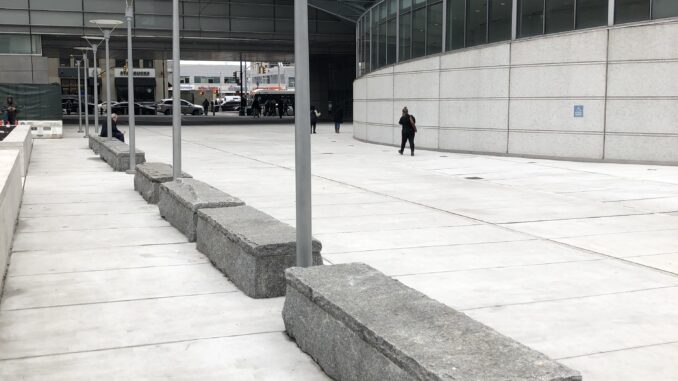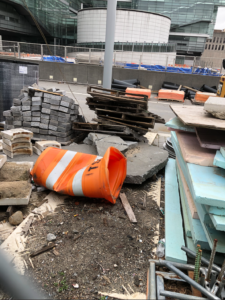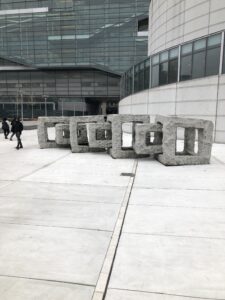
By Kevin Deutsch and Sasha Gonzales
[email protected] , [email protected]
The Bronx Hall of Justice’s civic plaza is at last partially open to the public, after a Bronx Justice News investigation revealed years of financial waste and construction delays at the controversial site.
Design problems, shoddy workmanship, and public safety concerns have kept most of the outdoor area closed since the courthouse’s 2008 opening, with just a small section of courtyard opening to the public in the mid 2010s. It closed again a short time later due to water leaking into lower areas of the building—a result of faulty construction, city officials said.
Twelve years after its construction, the full civil plaza has never been opened to visitors. But progress, official say, is being made.
Renovation work on the plaza remained at a standstill in 2019 – the sprawling space covered with tarp, trash, and unused construction materials – before Bronx Justice News’ investigation spurred the city bureaucracy to action.

Responding to BJN’s findings, City Councilman Ritchie Torres made an official referral to the Department of Investigation – over which his Investigations Committee has jurisdiction – a move that automatically triggered a DOI investigation of the Hall of Justice under city law.
With that investigation underway, a group of city officials gathered in the courtyard last month to announce the plaza’s partial opening. They lauded the progress at the construction site, but made no mention of DOI’s ongoing probe.
Nor did they address the millions in cost overruns, scores of lawsuits, or structural integrity problems that have plagued the property dating back to 2007.
“After years of the public plaza at the Bronx Hall of Justice being closed to the public, I am proud to see DDC taking action to bring this public space back to the residents of the Bronx,” Council Member Vanessa Gibson said at the opening. “Although more work needs to be done, this is the first step in restoring much- needed open space to the neighborhood.”

About 58 percent of the public space, or 28,335 square feet, is now accessible to the public, with the remaining 42 percent, or 20,005 square feet, slated to open later this year, according to officials from the Department of Design and Construction, which is overseeing a $40 million renovation project to address a host of infrastructure problems at the property.
The newly opened area includes benches, open space, and a walking path that allows pedestrians to quickly travel between East 161st Street and East 162nd Street.
“DDC is very pleased to be able to repair this public space and return it to the people of the Bronx,” said DDC Commissioner Lorraine Grillo. “In a few months, after the remaining trees are planted and the work in the plaza complete, more than one full acre of public space will have been restored for this busy community.
Prior to last month’s partial opening, the civic plaza – originally conceived as an “open and engaging” public space where visitors could take a break from legal matters – had instead come to symbolize less noble hallmarks of the city bureaucracy: government waste, lax oversight, poor planning, and infrastructure problems at the Hall of Justice; one of the most expensive taxpayer-funded projects ever completed in the Bronx.
Not Enough Staff to Secure Plaza
Well before the courthouses’s first day of operations in 2008, court officers responsible for ensuring the safety of visitors to the plaza saw potential for disaster: Weapons, drugs, and other illegal items could easily be tossed over the plaza exterior from adjoining streets; rocks and other projectiles could be hurled at the building’s glass exterior (the Hall of Justice also features a rooftop rock garden, which has never opened to the public); staffing levels were insufficient to properly patrol and monitor the courtyard; and not a single metal detector had been installed at plaza entry points, meaning smuggled items could easily be brought inside.
More than a decade has passed since those concerns were first raised, yet the city does not appear to have taken any steps to address them.
“Our main focus remains the safety and security for all staff and litigants inside the facility,” Lucian Chalfen, Director of Public Information for New York Courts, told Bronx Justice News recently. “While we are pleased that part of the plaza will be opened to the public, as we have stated previously, we don’t have the staff to safely secure the outside space. That would take resources from inside the courthouse which serves both Bronx Supreme Court and Criminal Court. Additionally, gang activity remains a problem in the area.”
The Hall of Justice is owned and maintained by the city, with the Department of Citywide Administrative Services responsible for day-to-day facilities management. The project’s construction was overseen by the state Dormitory Authority.
The DDC is responsible for the ongoing renovations at the property, which include repairs to the heating, cooling, and ventilation systems, as well as “conditions that are causing interior glass to break, removal and replacement of defective paint, repair of damaged ductwork in the garage area, and rehabbing of the building’s sewer line and plumbing vent line,” a DDC spokesman said last year.
Widely considered an architectural masterpiece, the $421 million Hall of Justice stands nine stories, spans two-and-a-half city blocks, and occupies 775,000-square-feet in what was, until recently, a blighted neighborhood.
Designed by renowned architect Rafael Viñoly, its arrival helped spur economic revitalization in the surrounding community: a bustling Starbucks recently opened across the street, a craft beer bar set up shop around the corner, and rents are rising amid a local construction boom, even as gun violence, poverty, and gang-related crime continue to plague the area.
But behind the building’s gleaming exterior lay a troubling history—one that began almost as soon as Mayor Rudolph Giuliani broke ground on the project in August 2001.
Construction on the courthouse ran three years behind schedule and $100 million over budget. The lowest-bidding contractor was disqualified because of suspected mob ties, and testing revealed soil at at the construction site to be contaminated with oil, spurring cost overruns and delays.
Just a few years after opening, the Hall of Justice was already involved in a host of lawsuit claims involving more than 30 parties, from government agencies and builders to engineers and contractors. The Dormitory Authority paid out millions of dollars in settlement money, and also recouped some in judgements, records show.
The problems with the courthouse didn’t end there: a construction worker pouring concrete at the construction site was killed, the building’s supposedly bomb-proof glass panels were regularly damaged, and a 75-foot canopy at the courthouse’s entrance was removed after inspectors deemed it unstable. The initial inspectors who improperly signed off on the canopy work were not certified, officials said at the time.
The matter was referred to the Bronx District Attorney’s Office and U.S. Attorney’s Office in 2007, but no charges were ever brought.
The late-2000s saw more problems: Roof leaks, flooding, mold, power outages, and broken elevators and escalators
The project’s construction manager, Bovis Lend Lease, used numerous contractors at the courthouse site. The company, one of the world’s largest construction firms, admitted to a massive over billing scheme on New York projects in 2012. They were hit with $56 million in fines and restitution fees as a result.
A different company, Hill International, handled the project’s the final phase.
The primary contractor for the ongoing courtyard work is Lanmark Group Inc., of Brooklyn.
Despite massive expenditures by the city and state, no government agency has ever said how much the plaza has cost taxpayers.
In response to a Freedom of Information Law filing by Bronx Justice News last year, the state Dormitory Authority said it could not locate any records showing how much it spent to design and build the plaza, despite their having paid more than two dozen contractors to construct the Hall of Justice.
City officials, including former Bronx Councilman G. Oliver Koppell, called for an official city investigation of the courthouse’s myriad problems as early as 2009.
One had never been opened before Bronx Justice News published its findings last year.
